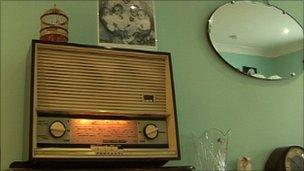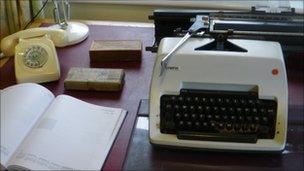Care home turns back the clock on dementia
- Published
Pat, a resident in the care home, says it's somewhere you can think about things
There are estimated to be over 35 million people suffering from dementia worldwide and as people continue to live longer the problem is expected to worsen. But a care home in England's Wiltshire countryside is piloting an innovative new scheme to improve the symptoms of their residents affected by dementia, as Jerry Sullivan reports.
Coombe End Court, a residential care home in Marlborough, has recreated 1950s style rooms to allow residents to tap into memories of their youth.
Pat is one of the residents of the care home. She is sparkly and chatty and remembers the past better than the present.
One of the pieces from the room that provokes the most positive response from her is the working vintage radio.
"I remember my mum saying that I would wear a hole in the carpet. I loved the radio and I loved dancing," she told the BBC World Service.
"I'm 80 something, I don't mind, I don't feel it. I run and I dig in the garden. Life's not just for sitting down and sleeping. It's fun."

The vintage radio brings back memories for Pat
Lease of life
From an initial conversation with Pat, you would never guess she has severe dementia.
According to care home manager, Sue Linsley, Pat was previously very quiet and withdrawn.
That has now changed and she's got another lease of life. "She goes out a lot, she's got friends that take her out. She's living her life."
It was Sue's idea to transform rooms in the unit into 1950s havens complete with furniture and decor from the era.
She told the BBC that because of the activities involved and the calming effect of the rooms, Coombe End Court have managed to reduce the use of antipsychotic drugs by 70%.
"Fifteen residents were previously on antipsychotics, there are now only three," she says.
In the main 1950s living room there is an old sewing machine, ceramic flying ducks on the wall, pictures from the time and other knick knacks.
There are racks filled with 1950s magazines and books reminiscent of the post war time.
Sue was able to make the room authentic by searching for items in junk shops and car boot sales, and placing advertisements for 1950s items that people wanted to donate.
Way forward
Many residents now appear to be much calmer and happier. One resident who was not able to move can now walk with the aid of a Zimmer frame.
"Patients are more alert, they are more engaging," says Dr Simon Manchip, consultant in old age psychiatry, who works with Coombe End Court.
He is impressed with the results from this simple and inexpensive idea and recognises it as an alternative treatment to antipsychotic drugs for dementia patients.
"These drugs do have a limited role, but if you are on them for a year you are twice as likely to be dead by the end of that year," says Dr Manchip.
"Nobody really wants their relative sedated and tranquilized. If they can get that emotional response back, you are getting closer to the person underlying the illness. I think this is really the way forward for dementia care."

Some residents recall memories of their workplace.
Doll Therapy
Some residents have stronger memories tied to their former professions. The 1950s office space includes typewriters, a vintage Bakelite phone and a record player.
Sue Linsley explains that some former doctors sit at the desk to bring back memories of their surgery. Some ex-typists also like the room as they remember how to use the equipment.
Another of the items donated for the room was a 1950s pram. The care home staff added dolls to the pram to make it more authentic.
For some of the patients dolls tap into memories of when they had children back in the 50s: one resident, Betty, remembers her children when they were babies as she holds the dolls.
"It doesn't work for every resident, but some really like it," says carer Grace Bowden. "They like that they are looking after somebody. Some of their roles were housewives, so they are going back to that."
1960s room
Most of the patients at this care home have similar memories from the 50s; so how can these rooms be made elsewhere where people's experiences of the time may be very different?
Manager Sue Linsley is convinced that the rooms can be made to suit any culture by focusing on the individual patient and what resonates with them.
As more patients come to the home, there are questions of how to deal with the next generation of patients. Sue Linsley thinks that this should not be a problem.
"We will have to change the rooms…I think this room will be worth while for quite some time; but obviously we will have to think about the sixties and I think that will be an interesting time to replicate."
- Published29 November 2010
- Published15 November 2010
